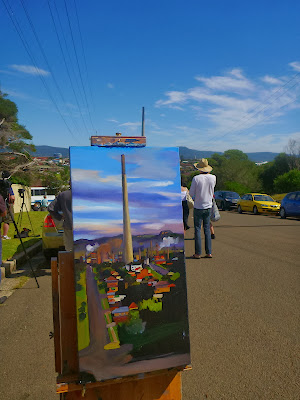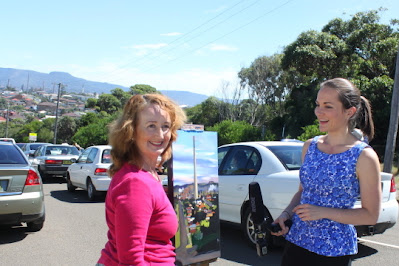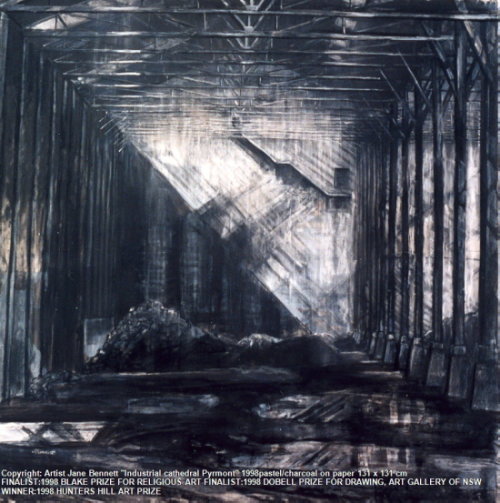The slender 198 metre-high tower, built from 7,000 tonnes of concrete, bricks and steel dominated the skyline since its construction in 1965."Stack"
A smokestack or chimney.
A fall or crash, a prang. noun or transitive verb e.g. he stacked his car on the weekend. (Australia, slang)
Port Kembla Copper first shut down in 2003, reopened under new owners and then finally closed in July 2008 after fierce campaigning by residents opposed to its sulphur dioxide emissions. Since the cessation of operations, the stack has been a decaying industrial anachronism standing defiant and abandoned.
Despite its chequered past, the stack became a treasured icon of Port Kembla's industrial past, a marine navigation tool and even a tourist attraction.
Unfortunately a viable alternative use for the stack wasn't found, so the stack was stacked.
Nearly 1,000 explosive charges were placed around it.
A 300-metre exclusion zone had been put in place for safety reasons before the sequenced detonation and over 250 residents were evacuated.Despite its chequered past, the stack became a treasured icon of Port Kembla's industrial past, a marine navigation tool and even a tourist attraction.
Unfortunately a viable alternative use for the stack wasn't found, so the stack was stacked.
Nearly 1,000 explosive charges were placed around it.
Most of the local residents, (as well as many ring-ins like me) lined up to watch the event just outside the exclusion zone.
 |
| Starting an oil painting of the Port Kembla Copper stack from Military Road at 6am Thursday morning 20th February 2014 |
I had spent Tuesday and Wednesday searching for the best viewpoint to watch the demolition before finally deciding to set up my easel on the top of Military Road.
It had many advantages. It was at the top of a hill even higher than the site of the stack, so that I would be roughly at the same height as the base of the tower. As I would be able to find parking at the side of the road close to the top of the hill, the view down the road would be clear of cars and trees, and there was enough room for many people to get a good view without too much jostling. There were even toilets nearby on Hill 60, in case it would be a long wait.
I thought that there could be quite a long wait before demolition as the police had to make sure that a very large area, part bushland, part residential and part industrial was completely clear.
This canvas shows the first rays of morning light on the last day of the stack.

Plein air oil painting of the Port Kembla Copper stack
from Military Road at 8am
Thursday morning 20th February 2014
It had many advantages. It was at the top of a hill even higher than the site of the stack, so that I would be roughly at the same height as the base of the tower. As I would be able to find parking at the side of the road close to the top of the hill, the view down the road would be clear of cars and trees, and there was enough room for many people to get a good view without too much jostling. There were even toilets nearby on Hill 60, in case it would be a long wait.
I thought that there could be quite a long wait before demolition as the police had to make sure that a very large area, part bushland, part residential and part industrial was completely clear.
This canvas shows the first rays of morning light on the last day of the stack.

Plein air oil painting of the Port Kembla Copper stack
from Military Road at 8am
Thursday morning 20th February 2014
I had arrived at 5.30am, as I had heard that roadblocks would be set up by 6am, and I wanted to get some painting done before the spectators got too distracting.

Plein air oil painting of the Port Kembla Copper stack
from Military Road at 9.30am Thursday morning
20th February 2014

Plein air oil painting of the Port Kembla Copper stack
from Military Road at 9.30am Thursday morning
20th February 2014
By about 9.30 it had become too crowded to paint effectively, but I really enjoyed the festival atmosphere.
By the time that the chimney was felled, the local journalists must have interviewed everyone in Port Kembla.
I met some fascinating people who had worked at Port Kembla Copper or Steelworks, or had been born, attended school or lived nearby, and felt that I had been adopted as an honorary local. Their hospitality was amazing.
The day before, I had been painting on this spot, just outside the house of a very kind man called Steve, who brought me cups of coffee every hour or so, which was greatly appreciated. He invited me to his stack party on Thursday, so I brought along the yummiest cake I could find in the local shops and tried not to get paint on it.
After a few too many demolition drinks Steve's son decided to enliven the monotony of waiting by streaking while one of the journalists was giving an interview. There were lots of bad puns about "wrecking balls", and a few sore heads the next day.
 |
I'm being interviewed in front of the canvas I had started early Thursday morning
|
I met some fascinating people who had worked at Port Kembla Copper or Steelworks, or had been born, attended school or lived nearby, and felt that I had been adopted as an honorary local. Their hospitality was amazing.
 |
| Plein air oil painting of the Port Kembla Copper stack from Military Road at 10am Thursday morning |
After a few too many demolition drinks Steve's son decided to enliven the monotony of waiting by streaking while one of the journalists was giving an interview. There were lots of bad puns about "wrecking balls", and a few sore heads the next day.
He wasn't the only one to be a little the worse for wear. Apparently a homeless man had climbed a security fence and settled down in bushland near the stack. I don't know if he was protesting, or just oblivious. Quite a few people had spent the day drowning their sorrows.
I believe that there were record crowds at the Steelworks Hotel, just outside the exclusion zone.
As more people gathered, I accepted the kind offer made by the owner of the ute parked behind my car to climb onto the tray for a better view. My half finished painting - the last painting of the standing stack- can still be seen in front of my car.
After a nerve-wracking wait after the first warning siren the chimney was finally brought down in a controlled explosion, about 11.15am.
The explosion wasn't as loud as I had expected; or maybe I'm just going deaf after years of painting on construction sites.
The little "cap" of the chimney flew off the top just before the pieces hit the ground.
 |
| A last view of the standing chimney from Military Road at about 11am Thursday morning 20th February 2014. My canvas is on my easel in front of my car. |
After a nerve-wracking wait after the first warning siren the chimney was finally brought down in a controlled explosion, about 11.15am.
The explosion wasn't as loud as I had expected; or maybe I'm just going deaf after years of painting on construction sites.
The little "cap" of the chimney flew off the top just before the pieces hit the ground.
 |
| Clouds of dust hover over the site |
After the explosion, a gigantic cloud of smoke and dust covered much more than the official exclusion zone for several minutes, before being blown out to sea.
This was another reason I had chosen this hill as a viewpoint, as it was close enough for a wonderful view, but out of the range of the dust cloud. I had studied the wind report for the day carefully before making my final choice of location.

I'm holding 2 small oil studies of before and after the explosion
Both paintings are painted on Thursday 20th February 2014
The one on the left was painted after the demolition.
The one on the right was painted before the demolition.
"View from Military Road, after demolition"
oil on canvas 15 x 31cm
"Port Kembla Copper stack from Military Road,
before demolition" oil on canvas 15 x 31cm
Enquiries
After the demolition, I knew that it would take several hours for the roads to be re-opened, so I kept painting. The people who jumped into their cars hoping for a quick getaway were sadly disappointed, as all they did was waste petrol while sitting fuming and stationary for over 3 hours. I've been told that it was the largest and longest traffic jam ever in the Illawarra.
I resumed painting, and in the photo above, I'm holding 2 small (15 x 31cm) horizontal canvases. They were painted close to the same spot; one painted before and the other after the stacking of the stackpot.

Both paintings are 61 x 31cm oil on canvas and painted February 2014
The one on the left was painted the day of the demolition.
The one on the right was painted the day before the demolition.
"Port Kembla Copper stack from Military Road,
on demolition day" oil on canvas 61 x 31cm
"Port Kembla Copper stack from Military Road,
the day before demolition" oil on canvas 61 x 31cm
Enquiries
This was another reason I had chosen this hill as a viewpoint, as it was close enough for a wonderful view, but out of the range of the dust cloud. I had studied the wind report for the day carefully before making my final choice of location.

I'm holding 2 small oil studies of before and after the explosion
Both paintings are painted on Thursday 20th February 2014
The one on the left was painted after the demolition.
The one on the right was painted before the demolition.
"View from Military Road, after demolition"
oil on canvas 15 x 31cm
"Port Kembla Copper stack from Military Road,
before demolition" oil on canvas 15 x 31cm
Enquiries
After the demolition, I knew that it would take several hours for the roads to be re-opened, so I kept painting. The people who jumped into their cars hoping for a quick getaway were sadly disappointed, as all they did was waste petrol while sitting fuming and stationary for over 3 hours. I've been told that it was the largest and longest traffic jam ever in the Illawarra.
I resumed painting, and in the photo above, I'm holding 2 small (15 x 31cm) horizontal canvases. They were painted close to the same spot; one painted before and the other after the stacking of the stackpot.

Both paintings are 61 x 31cm oil on canvas and painted February 2014
The one on the left was painted the day of the demolition.
The one on the right was painted the day before the demolition.
"Port Kembla Copper stack from Military Road,
on demolition day" oil on canvas 61 x 31cm
"Port Kembla Copper stack from Military Road,
the day before demolition" oil on canvas 61 x 31cm
Enquiries
After all the excitement, one of the local residents kindly took a photo of me holding my 2 vertical canvases of the Copperstack painted from the top of Military Road.
The canvas on the right was completed on Wednesday, while the one on the left was at the time still unfinished.
I had made sure to complete the painting of the chimney first, as I would be able to finish the houses, trees and the Steelworks in the background later.
Postscript : Afternoon in the ruins
After the demolition, I finished my paintings, then decided to wander around Port Kembla.
In the late afternoon, when the authorities had finally taken down the roadblocks, I set up my easel by the side of the road opposite where the stack had been. There were some young scruffy looking blokes hanging around, whispering to each other, so I was a little nervous. As darkness fell, a couple of them came up to me, so I braced myself to possibly have to make a quick getaway, although that's fairly impossible with a french box easel and a couple of wet canvases.
They asked me why I was hanging around and what I was doing there, so I showed them the paintings. They finally admitted that they'd been worried that I was some sort of security guard (?!) and they'd been hanging around until I left as they wanted to jump the fence and get a few bricks from the remnants of the stack as souvenirs. I pointed out that a security guard would probably be sacked if they did an oil painting of something they were supposed to be guarding. I looked just as odd and alarming to them as they did to me. We stopped being afraid of each other and I lent them my pliers and bolt cutters. One of them very kindly gave me a couple of bricks from the very top as a memento of my visit to Port Kembla.


Brick from the top of the Port Kembla Copper Stack


No comments:
Post a Comment